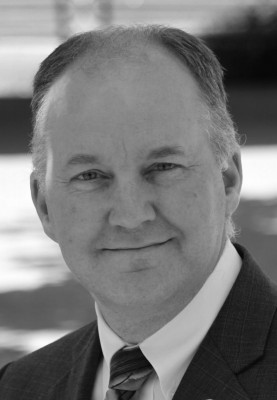 When A Doctor Becomes The Patient
When A Doctor Becomes The Patient
Dr. Kevin Anderson
Even with the education and experience Kevin Anderson had as a practicing physician, he couldn’t understand what was wrong with him. By 2008, what he did know was that the stairs he used everyday as a measure of his fitness had become, inexplicably, more and more of a challenge in the previous two years.
He had seen a cardiologist who had determined that the right side of Anderson’s heart had some problems, but the day that Anderson, still in his 40s, nearly fell down after climbing just one flight of stairs was the day he knew something was really wrong. Finally, an echocardiogram, a test that measures heart function, conducted about 18 months after his first, now showed his heart had thickened. The tissue of the muscle had changed drastically, so much so that a heart transplant might be required. Now, Anderson would hear the word amyloidosis for the first time and he would begin to learn more about the group of diseases that share the common dysfunction of depositing abnormal proteins in one or more organs of the body.

Five years ago, reading what he could find about amyloidosis in the medical literature was very scary, Anderson said. He also discovered that then, as now, his options for expert care were very limited: only a small handful of amyloidosis treatment centers in the United States, Stanford’s among them, provide the experienced multidisciplinary care amyloidosis requires.
Yet now, six years later, Anderson is well enough to have returned to his medical practice. He still lives with amyloidosis—there is no available cure—but the dysfunctional cells that once threatened his life are under control. “For Dr. Anderson to be looking and feeling as well as he is, it’s tremendous,” said Ron Witteles, MD, co-director of the Stanford Amyloid Center and one of Anderson’s doctors since his diagnosis in 2008. “And, fortunately, he is not alone.”
Witteles was the Stanford cardiologist who called Anderson shortly after Anderson learned that a heart transplant would be the first step in his care—and that Stanford would be willing to perform the surgery on a patient with amyloidosis. Typically, people with an incurable, underlying disease that could attack a transplanted organ aren’t considered candidates for a transplant. Even when it was first established five years ago, as the first treatment center in the Western United States for amyloidosis patients, Stanford was at the leading edge of care for amyloidosis.
Witteles and the Amyloid Center’s other co-director, hematologist Stanley Schrier, MD, assembled a team of specialists to care for patients with the systemic effects of the various forms of amyloidosis. “It had been heartbreaking to see patients receive this amyloidosis diagnosis and feel as though they had to uproot themselves to get the very best care,” Witteles said, “so that was part of our motivation to create a center in this part of the country. It’s a disease where until recently our treatment options were limited and we really wanted to do something to advance amyloidosis treatment.”
Although it had taken months for Anderson’s AL Amyloidosis to be identified, he was also lucky. If his kidney, liver or gut had been affected significantly, he would not have been a candidate for a transplant. But he recovered quickly from the heart transplant and was ready for the next step: a bone marrow transplant to replace his dysfunctional cells with those that would behave normally. Sixty to 70% of patients of patients with amyloidosis respond to that treatment; Anderson did not. Stanford had another option for him, a low dose chemotherapy regimen to suppress the activity of the dysfunctional cells. The combination worked. “I’m doing great,” Anderson said, “and every time I have a question that might be difficult to answer, I come back to my physicians here at Stanford and that’s been good.”
Witteles sees progress, too, in the Center’s efforts to educate other doctors and amyloidosis patients. “This is not a disease that comes out and smacks you in the face. You have to think about it. You have to be suspecting it and you have to have a pathologist who knows to look for it,” he said. The Stanford Amyloid Center also serves as a meeting place, quarterly, for the Northern California Amyloidosis Support Group.
He has also seen great progress in treatment options.”There are more effective therapies,” he said. “A decade ago, our chemotherapy options were extraordinarily limited. In the last five or six years, there have been a number of new therapies that have been used in different combinations, in different doses—and that is constantly evolving. What we think of as the go-to regimen today will probably be different in a year.”
The change has been so profound that Witteles sees a parallel between amyloidosis and diseases like HIV, where once the diagnosis came with few options for treatment—and now, much of the time, the disease can be treated as a serious, but chronic, condition.
Kevin Anderson was diagnosed with amyloidosis six years ago. With a heart transplant, a bone marrow transplant and chemotherapy, he is now healthy and back at work.
